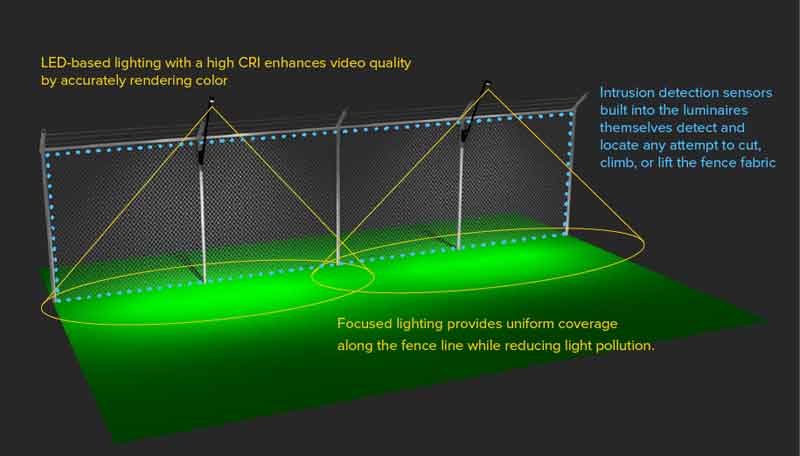
By Todd Brisebois, Product Manager, Senstar
Outdoor lighting is an important security tool.
A well-illuminated site – whether the entire site, a specific area such as a perimeter fence, or simply an entrance – is a less attractive target for would-be intruders than one where they can hide under the cover of darkness.
However, lighting is only a minor deterrent if intruders are determined to get inside.
There’s an adage in the security industry – passive systems like lighting and fences only keep honest people honest.
That’s where fence-mounted intrusion detection systems come in.
(Senstar LM100 is the world’s first intelligent perimeter lighting and sensing solution. Combining high performance LED lighting with accelerometer-based sensors, the LM100 deters potential intruders by detecting and illuminating them at the fence line. Courtesy of Senstar and YouTube)
Typically consisting of a cable or accelerometer-based device attached to the fence, they sense the vibrations caused by cutting, climbing or otherwise breaking through the fence fabric.
The fence becomes an active part of the security system, providing early warning while the intruder is still outside the building or protected area.
Having both lighting and intrusion detection systems working in parallel is a great security duo.
But, what if perimeter intrusion detection was built-in to the lighting system and could be used to control it?
One product performing two key security functions – deterring would-be intruders by eliminating the cover of darkness while detecting and locating those that aren’t deterred.

Combining security features into single products is trending in the industry and for good reason.
The performance, operational and cost benefits are obvious.
For example, video management is enhanced with analytics while video management and access control streamline daily operations.
 A hybrid perimeter intrusion detection and intelligent lighting system means only one system to install, maintain and manage, considerably saving time, reducing complexity, and lowering costs.
A hybrid perimeter intrusion detection and intelligent lighting system means only one system to install, maintain and manage, considerably saving time, reducing complexity, and lowering costs.
It also means more control over operation, enabling the lighting to react to the site’s current security status.
Intelligent Lighting as a Psychological Deterrent
The first step in any security program is DETERRENCE.
Avoiding intrusions in the first place is always the ideal outcome.
When broken down into individual deterrence mechanisms, intelligent lighting combined with intrusion detection provides:
-
Basic Site or Perimeter Illumination –
- Discourages would-be intruders while enhancing the effectiveness of camera surveillance systems.
- LED-based security lighting products dramatically reduce electrical costs when compared to traditional security lighting.
- In addition, the wide light spectrum of newer LED-based products provides a better Color Rendering Index (CRI) value that further improves camera surveillance.
-
Immediate and visible alarms –
- Intelligent lighting can provide localized instant-on, intensity adjustment, or alarm strobe features, announcing to would-be intruders that they are detected and their location is known (and presumably being recorded by the site’s security cameras).
-
Detection at the perimeter means earlier triggering of alarms and the automatic selection of camera views.
- For immediate deterrence, the system could enable or strobe fence lights within the immediate area of an intrusion attempt.

Motion Sensing vs Intrusion Detection
Motion sensors have been combined with security lighting for a long time.
While inexpensive and perhaps of some use in residential settings, the inherently high nuisance alarm rate (NAR) makes the technology unsuitable for most perimeter applications.
Motion sensing simply cannot distinguish between real threats and innocent events like a passerby or animal, or vegetation movement caused by high winds.
The resulting high NAR inevitably leads to complacency and/or higher costs associated with the unnecessary deployment of security personnel.
Vibration-based intrusion detection sensors on the other hand, provide a much higher level of security while minimizing nuisance alarms:
- While motion sensors respond to any nearby movement, vibration-based intrusion detection sensors only respond to threats on the fence itself (using algorithms to detect legitimate attempts to cut, climb or lift the fence fabric).
- Fence vibrations caused by weather can be avoided via rejection algorithms.
- Military grade, field-proven technology.
- Integrates with a site’s security system to enable a directed response at the intrusion location.

Hybrid Systems Simplify Deployment and Lower Costs
Consider the relative costs associated with enhancing perimeter security via a hybrid intrusion detection/lighting system:
Intrusion Detection Costs
- The material costs of intrusion detection systems are typically only 5–15% of the cost of the fence itself.
- When compared to the operating costs associated with providing a similar level of protection via additional security personnel (or dealing with the fallout of an actual intrusion event), fence-mounted intrusion detection systems are a bargain.
Security Lighting Costs
- Traditional security lighting remains expensive to install and operate, mostly due to the high electrical consumption of mercury vapor, metal halide, and high-pressure sodium lights.
- Switching to LED-based lighting technology, on the other hand, immediately reduces power consumption by as much as 90%.
- Additional savings are realized if lighting can be limited to just the protected areas or along the perimeter itself, instead of covering large areas that are inconsequential from a security perspective.
There’s another (often missed) benefit of targeted security lighting – being a good neighbor.
- If the site is located near residential or wildlife areas, light pollution caused by indiscriminate area lighting can be a concern.
- Downward, targeted lighting with dimming controls, focused specifically along the perimeter and key areas, improves security while minimizing light pollution.
Installation Costs
- Hybrid systems benefit from reduced infrastructure requirements and lower installation costs.
- Only one power cable needs to be installed, as well as only one on-site installation visit.
- In addition, hybrid systems may incorporate new inter-device wireless communication technologies, further reducing infrastructure requirements and simplifying installation.
Integration Costs
- Additional cost savings arise from the inherent integration advantages.
- One system means intrusion detection and lighting are controllable from a single interface, be it a shared software interface, contact inputs/outputs, or an included alarm display system.
- Custom integrations to link two separate perimeter systems become unnecessary, and support for the system becomes the responsibility of a single vendor, all of which led to better integrations.
Enhanced, Cost-Effective Security
The mainstream adoption of low-voltage LED-based technology has revolutionized the lighting industry, with new applications being introduced every day.
 The physical security industry is benefiting from these advancements and can expect new cost-saving products in the next few years.
The physical security industry is benefiting from these advancements and can expect new cost-saving products in the next few years.
Low-cost embedded accelerometers are also common-place, being present in virtually every smartphone and tablet.
This has driven down the per-unit cost, making hybrid intrusion detection and lighting products more affordable while still benefiting from mature detection and nuisance alarm rejection algorithms.
For the site owner (and security vendors supplying the goods and services), this means exciting new capabilities and reduced costs.
Hybrid 2-in-1 perimeter intrusion detection and intelligent lighting products may very well lead the next-generation of perimeter security systems, offering strong deterrent and detection features while enhancing the existing camera surveillance and access control systems.
About the Author:

Todd Brisebois is a Product Manager at Senstar Corporation, responsible for the new Senstar LM100™ hybrid perimeter intrusion detection and intelligent lighting system and the Flare® Real-Time Locating System.
He studied electronics engineering technology after which he moved to Ottawa, Canada’s “silicon valley north”.
Todd has worked at several high-tech companies designing products for the communications industry as well as a Field Applications Engineer for a global electronics supplier, helping a multitude of high-tech companies bring their products/visions to fruition.
Todd brings over 20 years of electronics experience to the security market.
(Learn More. Senstar has been manufacturing, selling and supporting the world’s largest portfolio of perimeter intrusion detection sensor technologies for more than 30 years. Senstar’s products and solutions can be found around the world in more than 80 countries, in tens of thousands of sites including borders, ports, military and government, correctional facilities, and other critical sites. Courtesy of Senstar and YouTube)
Click Here to Learn More about Senstar’s LM100 Hybrid Perimeter Intrusion Detection and Intelligent Lighting System, or to find out about all of Senstar’s full line of Perimeter Intrusion Detection solutions, World-Class Video Management Systems, and Personal Duress products, please visit the company’s website at https://senstar.com/.
Senstar offers a comprehensive suite of proven technologies that work together to reduce complexity, improve performance and unify support.
*Perimeter lighting with Senstar LM100 vs. perimeter lighting with High Pressure Sodium (HPS) lighting

















